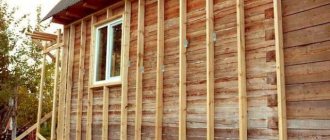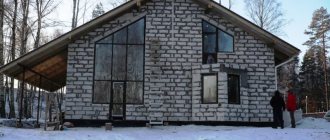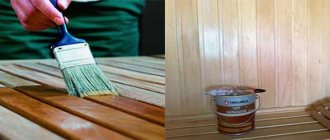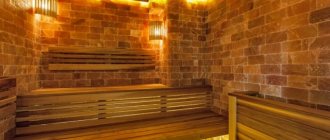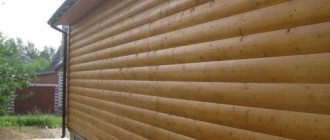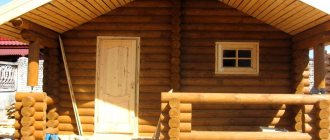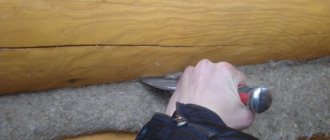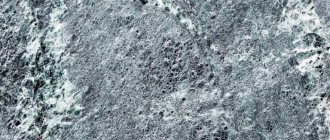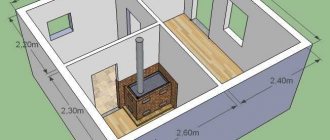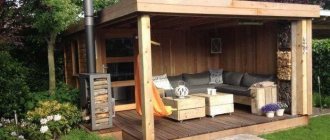Insulation of a foam block bath – Construction of saunas and baths
Insulation of a bathhouse made of foam blocks is an important stage of construction, on which the reliability of the structure and ease of use depend. The process of insulating such a bathhouse is quite simple and even a novice builder can do it.
Foam block walls do not require leveling after construction; their surface is almost perfect. Thanks to this, almost any finishing and insulation method can be applied to foam blocks.
Moreover, foam concrete blocks, due to their thickness and material characteristics, themselves are excellent thermal insulation. Therefore, insulating a bathhouse from such blocks will require minimal effort.
Finishing the walls inside a bathhouse made of foam blocks means protecting the foam blocks from regular exposure to moisture, in order to prevent deterioration of their characteristics, destruction and increase their service life. Before insulation, the walls must be treated with special impregnations with water-repellent properties, after which a special film insulation is made. But more about everything...
1. What needs to be done to insulate a bathhouse 2. Insulation for buildings made of foam concrete 3. Insulation of walls 4. Insulation of the ceiling 5. Insulation of the floor 6. Conclusion
What needs to be done to insulate a bathhouse
Let's consider thermal insulation options. This is done to ensure that the bathhouse is warm at any time of the year and that you feel comfortable and get maximum pleasure from taking bath procedures.
If, for some reason, the bathhouse cannot be insulated, then the heat will escape as quickly as possible. Accordingly, it will lead to financial losses, since the bathhouse will have to be repaired in the near future.
For a real bath, the temperature must be maintained.
Work on installing insulation for a bathhouse made of blocks is carried out in parallel with construction work . It all starts with insulating the foundation . It uses a material that is resistant to moisture, biological and temperature influences. The ideal option would be foam .
Installation of insulation is carried out after the concrete has hardened and the foundation formwork has been removed. The outside of the building is covered with a layer of waterproofing, after which it is covered with insulation sheets. The thickness of the insulation must be at least 5 centimeters. The best option would be to lay two layers of insulation 5 cm each in a checkerboard pattern.
After this, the surface of the foundation is plastered, preferably with “warm” plaster.
- The foundation in the bathhouse is insulated using mineral mats. A layer of expanded clay and slag is laid under the floor. To prevent the accumulation of moisture from inside the foundation, a ventilation hole is removed.
- Vapor barrier of walls . High-quality insulation of a bathhouse made of foam blocks is impossible without effective vapor barrier of the walls. The best material for this would be foil. It is laid on top of the insulation in vertical overlapping strips, without tension. Since foil is a rather thin material, it can be laid in two layers. The seams between the strips are sealed with reflective tape. The vapor barrier is installed in such a way that there is a small gap between it and the subsequent finishing of the bathhouse.
- A huge part of the heat escapes through window openings . Therefore, cracks that appear are sealed with any material that is less susceptible to burning. To eliminate fogging of glass, it is necessary to check how tightly the window frames fit to the frames. It will be very good if the windows have at least two glasses, and preferably three. But when insulating, it is worth noting that the shape of the windows must also be taken into account. The most optimal window shape is a rectangle that is elongated horizontally.
- To better retain heat, a small doorway . Doors and windows are required to be airtight.
- If in any place the thermal insulation is not done well or is simply not enough, this will have a significant impact on the heating of the bath.
Insulation for buildings made of foam concrete
It is usually recommended to use natural materials as insulation for bathhouse walls due to their environmental characteristics. For interior decoration, this requirement is justified. But synthetic insulation materials are also suitable for exterior decoration and insulation of baths. What materials are most often used for insulation?
Mineral wool is a popular material with good thermal insulation properties. It is resistant to high temperatures, withstands heating up to 1000 degrees, which allows it to be used not only for exterior, but also for interior decoration. Mineral wool is durable, resistant to biological influences, and is not susceptible to rotting or fungus formation.
Glass wool - has slightly lower thermal conductivity than mineral wool. For such a purpose as insulating a bathhouse made of blocks from the inside, it is not suitable due to its poor reaction to high temperatures. When worn out, glass wool emits an unpleasant odor, which also makes it unsuitable for interior decoration.
Jute felt is a natural insulation material of organic origin. Ideal for insulating bathhouse walls made of blocks inside and outside. It retains heat perfectly, is resistant to mold and mildew, has high strength and the ability to remove excess moisture from the room.
Expanded clay is a dry granular substance consisting of small balls of baked clay. Used for insulation of horizontal surfaces - floors, ceilings of bathhouses.
Polystyrene foam - usually used to insulate the outside of a bathhouse. They cover the facade with it, fixing it with glue or fasteners, and finish it with any chosen material - plaster, siding, panels.
Wall insulation
In order to insulate a bathhouse made of foam blocks, expanded clay or slag blocks, first of all, you need to choose insulation. Let’s say right away that the most environmentally friendly product in this situation will be felt, but since it is not available for sale on the construction market, we will have to choose from what is available. Foiled mineral wool
Based on the above data, we can come to the conclusion that in order to insulate a bathhouse made of expanded clay concrete blocks, of all the listed materials, mineral wool will be the most suitable (this includes stone wool, glass wool and slag wool). Its price is not very high, and you can choose the required thickness (from 20 to 200 mm) depending on the climate of your region. But in any case, you will need foil for waterproofing .
Foil polyethylene foam
If the mineral wool does not have a foil layer, then it needs to be added, and foil polyethylene foam, which you see in the photo above, is excellent for this. The thickness of such material varies from 2 to 20 mm, and by covering a layer of mineral wool with this, you significantly increase the effectiveness of thermal insulation.
U-shaped belt suspension brackets (pawns)
For wooden lining, that is, for cladding a steam room, you need a sheathing that will be attached to brackets, or it will be thick bars, between which insulation for the bath will be installed.
The second option is simpler, but installing timber on a block wall is not so easy, even if it is plastered.
The fact is that if the thickness of the sheathing is 100 mm, then anchor bolts will be needed to fasten it, which is not entirely acceptable for a wall made of such material.
Mineral wool is inserted through the consoles
We continue to consider how to insulate a cinder block bathhouse from the inside and will install the sheathing. Place some kind of waterproofing material on the wall, under the brackets, and then attach the consoles themselves with bod profiles. Mineral wool is threaded directly through the pawns, and then carefully covered with foil polyethylene foam, trying to ensure that no holes remain.
Advice! If you are interested in insulating plastic windows, then I can disappoint you - they are not insulated. Just so that they transmit less heat, you can use two-chamber or three-chamber double-glazed windows, as well as a thick, five-chamber plastic profile.
Ceiling insulation
Insulation of the ceiling in the bathhouse
The method of insulating the ceiling in a bathhouse made of foam blocks depends on the design of the roof.
If there is no plan to install a “working” attic , use an open type of ceiling insulation. In this case, the ceiling sheathing is covered with a layer of waterproofing, on top of which a layer of insulation is poured.
expanded clay is most often used for these purposes , covering it with a layer of at least 25 centimeters. But you can use the old-fashioned method - sprinkle the surface with sawdust and earth .
A layer of waterproofing is again laid on top of the insulation - roofing felt, polyethylene film, etc.
With a closed type of insulation, layers of insulation and waterproofing are covered on top with the attic floor. In this case, mineral wool is most often used as insulation. It provides the necessary thermal insulation with a thinner layer thickness than bulk insulation.
Installation of insulation occurs according to the same scheme as the insulation of bathhouse walls - vapor barrier, insulation, waterproofing layer. When thermally insulating and waterproofing a ceiling, only the installation plane changes.
Considering that there cannot be foam blocks on the ceiling, but, for example, a wooden floor or a concrete slab, timber can be successfully used as a sheathing.
Advice! To make it easier to install mineral wool on the ceiling so that it does not fall, use nylon thread. From beam to beam, a constriction is made in the form of a mesh, fixing the material.
Floor insulation
Bathroom floor insulation
The method of insulating a bathhouse floor depends on its design. If you are installing a “cold” leaky floor that has gaps between the boards to allow water to drain out, you will not be able to insulate it.
Insulation work can only be carried out with a “solid” non-leaking type floor. Such a floor is installed with a slight slope and equipment in the underground catchment area. To insulate a “deaf” floor, use mineral wool or expanded clay chips . The insulation is placed between the rough and finishing layers of the floor covering.
On the ground side, the insulation is protected with waterproofing; on the room side, a vapor barrier material is installed to protect the insulation from moisture. If a concrete floor is planned for the bathhouse, it is insulated by placing insulation in the screed. In the washing compartment you can install a “warm floor” system to provide additional comfort.
Conclusion
We looked at how to insulate a bathhouse made of foam blocks, and what material is most suitable for this.
Wood is an excellent insulation material, which means that the thickest wooden lining can be used (10-14 mm).
The use of wooden lining as a finishing material for a foam concrete bathhouse is a very popular solution, firstly due to the significantly lower price, and secondly due to its pleasant appearance and real aroma of wood, without which the bathhouse would not be the bathhouse that everyone knows.
It is advisable to make the floor in the bathhouse wooden or make a warm floor under the tiles on the floor. Sufficient care must be taken to seal all seams on doors and windows.
As you can see, building a bathhouse from foam blocks is not so difficult and you can probably do it. We hope that a bathhouse made of foam blocks will serve you for many years and delight you, giving you warmth and steam!
Source: https://www.proremont.ru/stroitelstvo-i-otdelka-bani/2613-uteplenie-bani-iz-penobloka
Ceiling insulation
The ceiling of the bathhouse also requires additional thermal insulation. According to the law of physics, heated air always rises, so the presence of defects in the design of the ceiling will lead to inevitable heat loss. The method of insulating the ceiling in a bathhouse is determined by the design of the roof. Most often, expanded clay is used to insulate a bathhouse, which is easy to install and affordable.
If you plan to build a bathhouse without a working attic, you should give preference to the open type of ceiling insulation. To do this, the ceiling lining is covered with a layer of waterproofing, on top of which a layer of insulation is poured. Most often, expanded clay is used, covering the material with a layer of at least 25 cm. In order to save money, you can use the method that was used before: sprinkle the surface with earth and sawdust. A layer of waterproofing is laid on top of the insulation - polyethylene film, roofing felt, etc.
We invite you to familiarize yourself with: Do-it-yourself finishing of a log bathhouse inside
For a closed type of insulation, layers of waterproofing and insulation are covered with the attic floor. In this case, the role of insulation is most often performed by mineral wool. It has the necessary thermal insulation with a smaller layer thickness than bulk insulation. Installation of insulation is carried out according to a similar scheme: vapor barrier, insulation, waterproofing layer.
Let's talk about how to properly insulate a bathhouse made of foam blocks
The main purpose of any bathhouse is to create and maintain a constant high temperature inside it and (if it is a so-called Russian bathhouse and its analogues) the formation of water vapor in the air, which has a beneficial effect on human health, helps cleanse the body, remove toxins - and simply gives great pleasure .
If the bathhouse is built from foam blocks, then it must be insulated - this is the most important part of the measures for its proper functioning.
About foam blocks
Recently, foam block baths have become especially popular, because a foam block is a material obtained by foaming an aqueous concrete or cement mortar mixed with sand and a special protein substance. It is thanks to the protein that a foam solution is formed, when it hardens, a mass is formed with a uniform distribution of tiny air bubbles inside it.
A bathhouse made of foam blocks is much more accessible to the general population due to the low cost of the material. It is quite possible for even an inexperienced person to build it.
Foam blocks are light, durable, fireproof and moisture resistant, but still a bathhouse built from them must be insulated - even despite the high strength qualities of this material.
Materials for wall insulation
Let's take a closer look at insulating materials.
Minvata
Mineral (basalt) wool is very popular and is most often used for external and internal insulation of bathhouse walls. Excellent heat retention, very durable and noise-reducing properties. This absolutely non-flammable material can withstand heating up to 1000 degrees Celsius.
Mineral wool is harmless and biologically neutral, i.e. resistant to the formation of mold and fungi.
Glass wool
Glass wool is inferior to basalt wool in thermal conductivity. Internal insulation of bathhouse walls is impossible with it, because... glass wool cannot withstand heating above 400 degrees. In addition, when this material wears out, it begins to emit an unpleasant odor, which is completely unacceptable for a bathhouse.
Felt
Jute felt is of organic origin and is very good for insulating walls both inside and outside. It retains heat perfectly, is durable, resistant to mold, and has the ability to remove excess moisture from the room.
Expanded clay
Expanded clay is a dry heat-insulating substance consisting of light, tiny balls of baked fusible clay. Used for filling horizontal elements of a bath structure - for example, a ceiling or floor.
Styrofoam
Expanded polystyrene (foam plastic) - ideal for external insulation of bathhouse walls made of foam blocks. Typically, external walls are covered with polystyrene foam, fixed with glue and fasteners, and then plastered (or other decorative material is used).
Vapor barrier of bath walls
The most important nuance when insulating the walls of a bath structure made of foam blocks is the correct use of a vapor barrier layer indoors, especially in the steam room. Foiled polystyrene foam is used as a vapor barrier.
When laying heat-reflecting and vapor barrier layers between the interior wall finishing and the insulation, an air gap must be left. The internal finishing material is attached to a wooden sheathing - a special frame that is fixed on top of the heat reflector.
Vapor barrier polystyrene foam is applied to the wall in two layers, while its sheets are combined with each other end-to-end or overlapping, without tensioning the material. Additional sealing is provided using metal (mirror) tape.
A layer of mineral wool can be laid on top of the foil insulating layer on the internal walls of the bathhouse, which is separated from the internal decorative upholstery by a layer of waterproofing. The resulting air gap can be equipped with a ventilation pipe, which will prevent the accumulation of moisture in the thickness of the wall of the bath structure.
Completion of work
When building a bathhouse from foam blocks, it is extremely important to insulate the floor. Usually the foundation itself is laid with mineral fiber mats. An air gap is also created here between the blocks, from which a ventilation pipe comes out.
From the inside, the floor of the bath structure is insulated with mineral wool or expanded polystyrene and must be equipped with a heat reflector - foil film or polystyrene foam.
The gaps between the blocks are filled with expanded clay, which allows for even more insulation of the floor and at the same time has an air gap necessary for additional ventilation.
Insulation of the walls, ceiling, roof and floor of the bathhouse is carried out according to the general principles of thermal insulation. All seams, joints, and cracks in the insulating material must be sealed. Window openings and doors are small in size, and the windows are given a horizontally elongated shape. All this allows you to maintain as much as possible a constant high temperature and (if desired) humidity inside the bath.
Source: https://x-teplo.ru/uteplenie/bania/uteplenie-bani-iz-penoblokov.html
Insulation of a bathhouse made of foam blocks: inside, outside, thermal insulation of walls
The advantages of foam blocks traditionally include lightness, fire safety, long service life and low cost. The successful combination of the characteristics described above turns it into one of the most common options when it comes to choosing materials for a bathhouse.
It is built in the shortest possible time and does not require significant financial investments. At the same time, the properties of the material and, first of all, its porous structure are vulnerable to cold and moisture.
In a bathhouse, given the specifics of the application, this requires additional insulation. The procedure is no different in complexity; you can order it from specialists or, after familiarizing yourself with the main points, perform it yourself. Careful work will be the key to a constant microclimate in the room, guaranteeing people warmth and comfort.
When starting the process of insulating a bathhouse, priority attention should be paid to the walls .
Here the main role is played by the internal frame, which ensures reliable fixation of the insulation and other materials used in the insulation procedure.
The insulation is evenly distributed under the frame, and then the structure is sheathed with waterproofing. Most often, it is based on foil and similar components, whose features prevent heat from escaping from the room.
As the name suggests, the material also serves as a reliable protection for walls and insulation from moisture. In no case should you neglect waterproofing, otherwise there is a high probability of mold, mildew and other unpleasant issues.
When the material is laid, the walls of the bathhouse are lined with wood. Here, ordinary lining or planed boards can be used with equal success. Along with interior decoration, external wall insulation is also used.
All features and stages of both procedures will be discussed below.
Important: wall insulation when building a bathhouse made of foam blocks may not be necessary, especially if the thickness of the blocks sufficient for your climate is used. It’s up to you to decide whether it’s worth insulating or not; further material will help you weigh the pros and cons.
Insulation materials
There is a huge amount of materials on the market for insulating foam block baths. Each of them has its own advantages and disadvantages, which this article will help you understand. So, most often used:
- Styrofoam . One of the traditional materials for insulation. Recently, it has been used less and less for walls, retaining heat worse than its competitors. At the same time, it seems to be the best option as insulation for the base and foundation;
- Glass wool . With proper waterproofing, it can reliably protect the room. Its structure includes glass production waste, sand, and felt. In general, it holds heat well, but the disadvantages include a specific smell during the aging process of the material;
- Expanded clay . It is used to insulate ceilings and floors by backfilling the corresponding areas;
- Jute felt . This is a completely natural material that is produced from the plant of the same name. In ancient times, felt was used in the production of burlap and other products, with excellent thermal insulation properties. The main advantage of the material is moisture rejection. As a result, along with insulation, it serves as additional protection against moisture. The disadvantages include fragility, as a result of which flax wool is on the market today, in which jute is combined with flax for greater strength;
- Basalt wool . Its main advantage is excellent fixation, which allows you to simply place the material under the frame without the use of dowels, etc. This is a mineral material, the result of processing certain rocks. In particular, as the name suggests, basalt wool is extracted from basalt. Today it has the highest thermal conductivity coefficient. Basalt wool is not subject to combustion, guaranteeing fire safety;
- Ecowool . An excellent choice for thermal insulation. It is a product whose structure consists of cellulose, antiseptics and fire retardants. When using it, you can do without vapor barrier, in addition, mice and rats do not eat the material. In Western Europe and North America, ecowool has been used for a long time; in Russia, its advantages are currently being actively studied;
- Waterproofing . Most often this is foil and materials made on its basis. Provide protection for materials and walls from moisture penetration, keeping them dry;
- Foiled polystyrene foam . Today, one of the most popular insulation methods is where polyethylene foam is covered with a protective layer of foil on top. It has the advantages of all the materials described above. It is durable, easy to install and long lasting. Among the disadvantages, the possibility of corrosion should be noted.
- Liquid insulation or polyurethane foam . It has been used relatively recently, having already noted excellent sealing properties, heat and sound insulation, absolute resistance to moisture, and an almost endless service life. It grips well on any surface and does not require the creation of a frame.
Insulation technology
Regardless of the type of material chosen as insulation, the following technology should be followed in the process. First of all, the floor is insulated, then the walls are equipped and at the final stage the ceiling is completed with materials.
The specifics of insulation presuppose the beginning of its use already at the construction stage, when builders use additional materials to protect the foundation and base.
Attention! It is important to use components that can easily withstand temperature changes, exposure to the environment, and are not subject to rotting and decay.
Insulation of a bathhouse made of foam blocks from the inside
In the video, pay attention to the explanation of why a bathhouse, unlike a residential building, is usually better insulated from the inside:
Internal insulation of walls made of foam blocks begins with filling the frame. Its function is perfectly performed by boards or slats with the indispensable condition of having enough indentation to accommodate the insulation. It is advisable to leave small holes in the upper part of the wall .
They are called vents , promoting additional ventilation. Windows are equipped with shutters or plugs are used to plug them during bathing procedures. The rest of the time it is recommended to keep them open.
As a result, moisture will not accumulate and the walls will remain dry.
After the frame is stuffed, the material chosen as insulation is attached to it. Depending on the choice and specifics, it can be fixed with nails, dowels, or simply inserted into the gaps. As already noted, it is desirable to use a component that has protective properties against rotting. Today, jute felt has the best performance on this point.
The most important step in insulating bath walls is vapor barrier . It must be used in two rooms, namely the washing room and the steam room. Without steam insulation, concrete and foam blocks will not be able to withstand increased exposure to moisture, not to mention maintaining the desired temperature, and will begin to deteriorate over time.
Along with the already mentioned foil and materials created on its basis, mirror film helps to isolate steam well. When laying the material, tension should be avoided by joining its elements to each other or by overlapping installation. Vapor barrier is relevant for the steam room and washing room; the dressing room and rest room can do without it.
After waterproofing the walls, they cover them with boards. This is the final stage of internal thermal insulation. It involves the use of antiseptics. Being applied to the boards they protect them from mold, mildew, bugs and other typical troubles.
External insulation
The outside of the baths is insulated using the ventilated façade technique with the necessary air gap. Foam plastic, jute felt and mineral wool have proven themselves well as materials here.
The main selection criterion here is cost.
In terms of its importance, external insulation in a bathhouse is significantly inferior to internal insulation , and it is left for later, and sometimes (if the climate and region allows) it is not used at all.
The floors and ceilings in the bathhouse are necessarily insulated, forming a single protective environment, without which the process cannot be considered complete.
Photo
So, if you master the technology, insulating a bathhouse from foam blocks is quite easy. The main factor here is the competent choice of material and its proper arrangement, and the emphasis is on internal work.
If you have time and desire, you can do the whole process yourself. If for one reason or another this is not possible, it is enough to contact a specialist.
In any case, the owner will have at his disposal a warm and comfortable bathhouse, always ready to welcome everyone into its arms.
See also : foundation and finishing of foam block baths.
Article in sections: How to build a bathhouse from foam blocks
Source: https://parilochka.com/vybor/penoblok/kak-stroit/uteplenie.html
How to insulate a bathhouse made of foam blocks from the inside with your own hands?
A building made of foam blocks has many advantages: light weight and high thermal insulation properties. But a structure made of this material requires mandatory cladding, both external and internal. This is due not only to increased visual appeal, but also to the high porosity of the foam block.
That is why walls built from porous material need reliable waterproofing. This issue is especially acute when finishing the inside of a bathhouse. Today we’ll look at how to properly carry out waterproofing work and at the same time insulate a foam block bathhouse.
Used insulation materials
High temperature and humidity prevail in the bathhouse. Based on these operating conditions, thermal insulation materials are selected. The main requirements for bath insulation are heat and moisture resistance. When insulating a bathhouse from the inside, experienced craftsmen recommend using the following materials:
- Mineral wool has gained great popularity due to its properties. Resistance to high temperatures, mold and microorganisms makes its use quite justified. A significant advantage of this heat insulator is its affordable price.
- Jute felt is an organic insulation material. Its natural origin will greatly appeal to lovers of all things natural. Excellent thermal insulation properties and a fairly high price are the main characteristics of this material.
- Polystyrene foam and other foam insulation materials. They are light in weight and easy to install, and practically do not absorb water. The disadvantage is their instability to high temperatures, so it is not recommended to use polystyrene foam in the steam room.
Advice! In order to efficiently and reliably insulate the bathhouse floor, expanded clay backfill is most often used. This material is characterized by its availability, high mechanical strength and thermal insulation properties.
Bath insulation technology
To properly insulate a bathhouse made of foam blocks, it is necessary to cover all surfaces: floor, ceiling and walls with thermal insulation materials.
Floor insulation
You need to think about floor insulation even at the stage of building a bathhouse. To increase the protection of walls from groundwater, a layer of waterproofing should be laid between the foundation and the foam block masonry. Most often, ordinary roofing felt or similar materials are used for this.
Having erected the walls, you can proceed directly to the equipment and insulation of the floor. All work in this direction is as follows:
- The earthen base is leveled and covered with thick polyethylene in several layers. This is done to prevent moisture from seeping into the insulation layer.
- Then a layer of expanded clay, at least 10–15 cm, is poured in and compacted thoroughly.
- You need to make a cement screed on top of the expanded clay. In this case, you should use a reinforcing mesh, which can be placed directly on the expanded clay or buried in the thickness of the mortar during the process of pouring the floor.
- The top layer of the screed must be carefully leveled using a long rule.
After the cement screed has dried, the rough floor of the bathhouse is ready. Now it can be tiled with ceramic tiles or a wooden floor can be made.
Ceiling insulation
Without reliable thermal insulation of the ceiling, it is impossible to properly insulate the bathhouse from the inside. More than 90% of thermal energy rises to the ceiling and evaporates. There are two methods for insulating the ceiling:
- The first method requires the use of foil, which is placed on the ceiling of the bathhouse from the attic side. Then the foil is covered with a layer of waterproofing and the entire space between the rafters is filled with fine expanded clay. Then the expanded clay is covered with another layer of plastic film on top and the roof can be installed.
- The second method is more suitable for a bathhouse with an attic. In this case, instead of expanded clay, you can fill the ceiling with clay mixed with sawdust. The effective layer of such coating is 20–25 cm.
Wall insulation
In order to properly insulate the walls of a bathhouse from the inside, it is necessary to use frame technology:
- Wooden sheathing is mounted on foam block walls.
- A layer of waterproofing material is installed.
- Insulation is being installed.
- Then you need to install another layer of vapor barrier.
Advice! To increase thermal insulation properties, it is best to choose a vapor barrier material based on foil. This will shield thermal energy, thereby reducing heat loss.
Based on the above material, it is quite easy to insulate a bathhouse. A distinctive feature of such work for a structure made of foam blocks is the use of a large amount of waterproofing material. A properly insulated sauna will last a long time and bring a lot of positive emotions.
Source: https://utepleniem.ru/banya/kak-uteplit-banyu-iz-penoblokov.html
Criteria for choosing material for finishing
When choosing finishing materials, you should be guided by the following parameters:
- Waterproofing.
Wall cladding must be resistant to high humidity and steam.
- Resistance to high thermal loads.
During operation, there should be no warping, cracking or deformation of the cladding.
Bath finishing materials
- Fire safety.
You need to choose a material that will not catch fire even when in contact with an open flame.
- Environmentally friendly.
It is better to use natural materials that do not emit harmful or toxic substances at high temperatures.
- Strength and durability.
The interior decoration of a bathhouse made of foam blocks is not done for one year. These criteria determine how often it will require repairs, so choose a cladding that is less susceptible to mechanical, chemical and thermal damage.
- Smooth surface.
Caring for a corrugated or ribbed surface is quite problematic, and nicks or chips can be harmful to health. When purchasing, pay attention to the appearance of the material.
How to insulate a foam block bathhouse from the inside – Construction and repair
A building made of foam blocks has many advantages: light weight and high thermal insulation properties.
But a structure made of this material requires mandatory cladding, both external and internal.
This is due not only to increased visual appeal, but also to the high porosity of the foam block.
That is why walls built from porous material need reliable waterproofing.
This issue is especially acute when finishing the inside of a bathhouse.
Today we’ll look at how to properly carry out waterproofing work and at the same time insulate a foam block bathhouse.
How to insulate the walls of a bathhouse made of foam blocks?
Previously, we already wrote about the construction of a bathhouse from foam blocks, where we examined several layout options and looked at how blocks are laid from this modern material, which has recently been gaining popularity in the construction of bathhouses. Foam blocks, unlike logs, beams or frame-panel structures, do not burn , do not support the spread of rot and mold, are not susceptible to woodworms and have high thermal characteristics.
In this publication, let's look at how to insulate walls made of foam concrete, what materials for insulation are best to choose, and how to make insulation in different rooms of a bathhouse.
Design features of bath walls
A special feature of the design of bath walls is the requirement for their thermal characteristics in combination with resistance to moisture, and in a steam room also resistance to elevated temperatures.
Moreover, unlike a country house, where at different times of the year a comfortable air temperature must be ensured with the least energy consumption, in a bathhouse the walls should retain heat only for the duration of its use, that is, periodically from time to time.
This allows you to reduce the amount of construction work by reducing the thickness of the wall and installing a stove of sufficient power that quickly warms up the room. It is believed that in a steam room the walls should be especially carefully waterproofed so that moisture from the room is not absorbed into the porous foam blocks.
This is partly true; the porous structure of foam blocks reduces their frost resistance, and if they get wet and subsequently freeze, such blocks can crack quite quickly.
At the same time, when visiting a bathhouse, the amount of water used in the steam room can be only 2-3 ladles of water, which, you see, is not the amount of moisture that can wet the walls enough to cause them to freeze.
A properly selected stove provides good draft, quickly “pumping” moist air outside the bathhouse.
And in order to expel humid air from the interior of the bathhouse to the street, after the bath procedures it is enough not to immediately put out the stove, but leave it to burn for another 15-20 minutes, throwing in 2-3 logs.
Insulation of a steam room made of foam blocks
You should take the most responsible approach to the choice of materials and insulation design in the steam room.
The insulation material should not emit toxic substances and withstand high temperatures well. Mineral wool can be an excellent choice.
Its advantages as insulation for a steam room include the following qualities:
- high value of heat transfer resistance;
- mineral wool does not burn;
- does not emit odor or harmful substances;
- does not support the spread of mold and mildew;
- not susceptible to being eaten by rodents and woodworms.
Mineral wool materials are perfect for insulating walls and ceilings in a steam room.
To lay heat-insulating material on the walls, wooden blocks with a thickness equal to the thickness of the insulation layer are hammered at intervals equal to its width.
Thermal insulation is rolled out between the bars, covered on top with a layer of vapor-waterproofing material (foil) and sewn up with clapboard.
To ensure air circulation between the insulation layer and the interior finishing, the lining is nailed onto an additional sheathing placed on top of the vapor barrier layer.
In general, the layers of the thermal insulation “pie” of foam block walls look like this:
The process of finishing interior walls with clapboard
Many people perform cladding using wooden lining. The advantages of wood are obvious to everyone - it is durable and beautiful, but when using it, all the nuances must be taken into account. For example, lining made from coniferous trees cannot be used where temperatures are always high, that is, in steam rooms, since when it is heated, sticky resins are released. They are dangerous to the human respiratory system. Quite often mold forms in bathhouses.
Antiseptics of various types help to cope with this, so it is better not to decorate the washing room with clapboard. Cheap pine paneling is used in dressing rooms. Deciduous trees are needed in the steam room. The most reliable and durable oak lining. However, currently aspen lining is most often used.
